Networks FINAL
1/48
There's no tags or description
Looks like no tags are added yet.
Name | Mastery | Learn | Test | Matching | Spaced |
|---|
No study sessions yet.
49 Terms
Simplified TCP events → Sender Side
(1) Data received from application: Packet → Sequence Number
(2) ACK received
(3) Timeout: One timer → Oldest packets (smallest sequence number)
Timeout = retransmit
TCP Receiver events → explain?
(1) arrival of in-order segment with expected seq #. All data up to expected seq # already ACKed
delayed ACK. Wait up to 500ms for next segment. If no next segment, send ACK
(2) arrival of in-order segment with expected seq #. One other segment has ACK pending
immediately send single cumulative ACK, ACKing both in-order segments
(3) arrival of out-of-order segment higher-than-expect seq. # .Gap detected
immediately send duplicate ACK, indicating seq. # of next expected byte
(4) arrival of segment that partially or completely fills gap
immediate send ACK, provided that segment starts at lower end of gap
TCP Fast retransmit
Occurs when the senders gets at least 3 of the same ACKs, it fast retransmits the packets to recover faster since it knows the packet is loss/corrupted
After receiving 3 additional ACKs for same data, resend unACKed segment with smallest sequence #
Likely that unACKed segment lost, so don’t wait for timeout
TCP Flow Control
Receiver:
rwnd = Total capacity - (used buffer) => rwnd = RcvBuffer – [LastByteRcvd – LastByteRead]
Sender:
Can’t send more data to receiver if rwnd = 0
With persist timers, if the sender does receive the rwnd = 0, the persist timer starts. If the timer expires, the sender then sends 1 byte of data to probe the receiver and see if there is space.
Define Congestion in Computer Networks
informally: too many sources sending too much data too fast for network to handle
Lost packets (buffer overflow at routers)
Long delays (queueing in router buffers)
Additive increase and multiplicative decrease
approach: sender increases transmission rate (window size), probing for usable bandwidth, until loss occurs
additive increase: increase cwnd by 1 MSS (Maximum Segment Size) every RTT until loss detected
multiplicative decrease: cut cwnd in half after loss
TCP Congestion Control: Details
Sender limits transmission: LastByteSent - LastByteAcked <= (less than or equal to) cwnd
TCP sending rate: send cwnd bytes, wait RTT for ACKs, then send more bytes… rate ~ cwnd / RTT (bytes/sec)
End to End Congestion VS Networks Assisted Congestion
End to End Congestion:
No explicit feedback from network
Congestion inferred from end-system observed with loss and delay
Approach taken by TCP
Networks Assisted Congestion:
Routers provide feedback to end systems
Single bit indicating congestion
Explicit rate for sender to send out
T/F: Standard TCP Congestion Control uses network assisted approach
FALSE
Explain Bandwidth Probing
Increase rate in response to arriving ACK until loss event occurs, then decrease sender’s rate
TCP Tahoe and Reno
Tahoe
After loss, go to slow start
Reno
After loss, skips slow start and keeps adding one (no exponential)
Has fast retransmit compared to Tahoe NOT having it
Explain TCP congestion control stages
(A) Slow Start:
cwnd = 1 MSS at beginning, double cwnd every RTT, increment cwnd for every ACK
additive increase and multiplicative decrease
(B) Congestion Avoidance (CA)
If cwnd > sstresh, when cwnd gets to 1/2 of its value before timeout. If so then switch from exponential to linear
Both (A) and (B) are Mandatory Taho
(C) Fast Recovery:
Sender takes account of duplicate ACK
duplicate ack is when cwnd = +3
Cut window by half then add 3 to it, retransmit the packet
(A), (B), (C) are all in Reno
Main function of Network Layer
Provide Host-to-Host communication
What are the two planes of Network Layer and their functionalities
(1) Data plane (Hardware)
Local functional in charge of forwarding
Uses the header ith the forwarding table
(2) Control plane (Software)
Global functionality in charge of routing
Two methods:
Traditional routing algorithms:
Individual routing algorithm components in each and every router interact in the control plane
Routing algo function in one router communicates with other router to compute forwarding table values
Traditional = routers
Software-defined networking:
Remote controller computes, installs forwarding tables in routers
might be implemented in remote data center managed by ISP or third party
Communicates with router by exchanging messages contains forwarding table and some routing information
SDN = remote servers
Two types of Control planes Traditional VS SDN approach
Traditional:
Router does both the routing and forwarding
SDN:
Remote server has remote controller that computes, installs forwarding tables in routers
Why Network Layer provided by IP is called “best effort”
It’s trying its best to provide a service
No guarantees on:
Successful datagram delivery to destination
Timing or order of delivery
Bandwidth available to end-end flow
What are the main functions of input and output ports
Input port functions:
physical layer: bit-level reception, Physical link Termination
link layer: Needed to interoperate with other side of link e.g., Ethernet
switching: using header field values, lookup output port using forwarding table in input port memory.
control packets are forwarded to routing processor. Goal: complete input port processing at ‘line speed’
input port queuing: if datagrams arrive faster than forwarding rate into switch fabric
Forwarding:
destination-based forwarding: forward based only on destination IP address (traditional)
generalized forwarding: forward based on any set of header field values
Output port functions:
stores packets received from switching fabric
Transmit packets on outgoing link
Performs necessary link layer and physical layer functions
Discuss destination based forwarding
One of the input port functions for Forwarding is called Destination-based forwarding and it's a forwarding technique that is based only on the destination IP address (just like the traditional approach for the control plane routing algorithms). The internet uses this forwarding approach as it helps determine the next router to go to based on the packet's destination.
First, the router has a table called the routing table that it uses to map the destination IP address to the next router IP address it hops to. Any time a packet arrives at the router, it reads the desination IP address from the packet header then uses it as a key on the routing table. If a router got a packet with the destination IP address of 192.172.4.16, it would check the routing table for any entry that has 192.172.4.X network to send the packet to the next router. If there is no entry, it uses the "longest prefix matching" to get the closest match with this packet. Then the packet is forwarded to the next router IP address it hops to and this keeps going until it reaches it's destination.
Main function of Routing processor based on traditional and SDN
Traditional:
Execute routing protocol
Maintain routing table and attached link state information
Computes forwarding table
Routing on router
SDN:
Responsible to communicate with Remote controller
Get Forwarding table and install it in input ports
Routing in remote controller
How switch fabric operators work
(1) Memory:
First generation routers, computers switch under direct control of CPU (oldest so one packet at a time)
packet copied to system’s memory
Speed limited by memory bandwidth
Single memory read write, so two packets can’t be forwarded at the same time, even if different O/P port (ONLY ONE A TIME, One input one output)
(2) Bus:
Datagram from input port to output port via a shared port
Input can send multiple in bus, output is one at a time
If multiple packet at same time all but one must wait as bus can transfer one packet at a time
Regardless of different ports or anything, doesn’t matter how many come in and only one gets out
(3) Interconnection network:
Scaling uses multiple switching “planes” at the same time
Packets are forwarded through a switching fabric made up of interconnecting paths.
Multiple packets can be transferred simultaneously, depending on the internal structure.
Why switch fabric speed ideally NR?
N = # of input ports
R = transmission rate of individual link
Because if it’s less than NR, packets get dropped/queued because it can’t switch as fast as the input port are transmitting data. If equal or greater than, then it ensures max throughput and simultaneously transfer packets
Discuss queuing at input port and output port of individual link
Input port:
Input has forwarding, there’s processing delay as it’s waiting for it’s turn
Cross reference local forwarding table
Output port:
Queueing delay
Which packet is better and why? (A) FIFO, (B) Priority, (C) Round Robin, (D) Weighted Fair Queuing
(D) Weighted Fair Queueing
Generalized Round Robin
Each class (I), has weight, wi and gets weighted amount of service in each cycle
Minimum bandwidth guarantee (per-traffic-class)
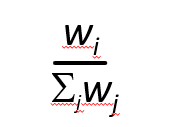
Usage of TTL
TTL = Time To Live which is remaining max hops to destination router
Why IP protocol needs to compute checksum at every router?
The reason the router has to calculate the IPv4 header checksum again is because the header's element with the TTL (remaining max hops) and the options change. This is all to ensure that the datagram changes are being presented every time the packet goes through the router
Which IPV4 headers are not available in IPV6
Header checksum, Fragmentation, Options field
T/F: Each host at most have one IP address (Hint: Who gets IP address)
FALSE - Host can have different interfaces
Convert IP address to dotted decimal notation: 11111111.00001000.00000001.00000011
Convert each section:
11111111 => 255
00001000 => 8
00000001 => 1
00000011 => 3
So in the end you get 255.8.1.3
What is the 32-bit binary equivalent of the IP address 127.0.0.1, 255.255.255.255, 1.0.0.0, and 192.168.1.1?
127.0.0.1 => 01111111.00000000.00000000.00000001
255.255.255.255 => 11111111.11111111.11111111.11111111
192.168.1.1 => 11000000.1010
What is subnet? What is subnet mask?
Subnet:
Device interface that can physically reach each other WITHOUT passing through an intervening router
Isolated network is a subnet (look at picture from slides)
Subnet mask:
IP addressing assigns address to subnet
/24 means high-order 24 bits: Subnet is part of IP address
Ex: subnet 223.1.1.0/24 means you can have 254 usable addresses
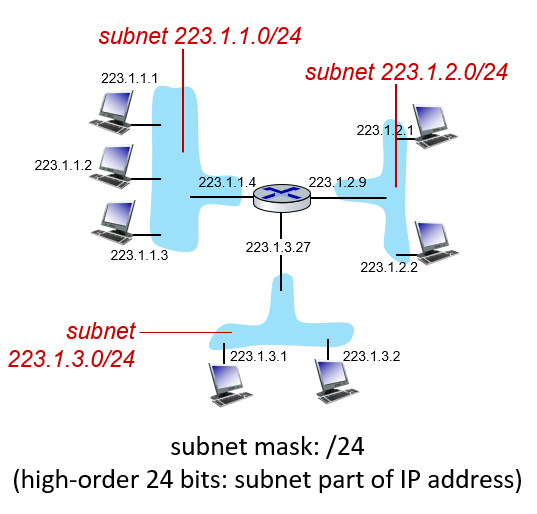
How subnets receive IP address?
ICANN: Internet Corporation for Assigned Names and Numbers
allocates IP addresses, through 5 regional registries (RRs)
manages DNS root zone, including delegation of individual TLD (.com, .edu , …) management
Classful vs (CIDR)
CIDR: Classless InterDomain Routing
Generalize the notation for subnet addressing
subnet portion of address of arbitrary length
address format: a.b.c.d/x, where x is # bits in subnet portion of address (x also known as network prefix)
Classful:
Before CIDR, network prefix was constrained to 8-, 16-, 24-bits in length
8-bit = Class A, 16-bit = Class B, 24-bit = Class C
Class C can have 256-2(special use)=254 only hosts : Too small
Class B can have 65536 - 2 = 65534 too big
Disadvantage: Rapid depletion of class B and poor utilization
How DHCP works? What other info it provides?
Also T/F: DHCP is a network protocol?
DHCP: Dynamic Host Configuration Protocol
Goal: host dynamically obtains IP address from network server when it “joins” network
allows reuse of addresses (only hold address while connected/on)
DHCP can return more than just allocated IP address on subnet:
address of first-hop router for client
name and IP address of DNS sever
network mask/ subnet mask (indicating network versus host portion of address)
FALSE, is considered an application protocol
NAT → Scenario
NAT: Network address translation
all devices in local network share just one IPv4 address as far as outside world is concerned
Private IP stays private
Uses translation table
(1) Replace: outgoing datagrams: replace (source IP address, port #) of every outgoing datagram to (NAT IP address, new port #)
(2) Remember: (in NAT translation table) every (source IP address, port #) to (NAT IP address, new port #) translation pair
(3) Replace: replace (NAT IP address, new port #) in destination fields of every incoming datagram with corresponding (source IP address, port #) stored in NAT table
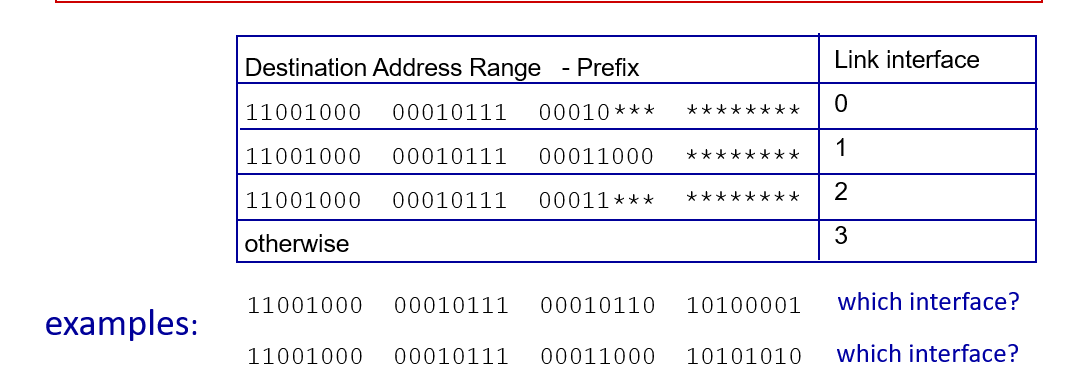
Longest prefix matching
when looking for forwarding table entry for given destination address, use longest address prefix that matches destination address.
Ex: Interface 0 and interface 1
Switching fabrics
Connects router's input ports to output ports
transfer packet from input link to appropriate output link
Switching rate: rate at which packets can be transfer from inputs to outputs
often measured as multiple of input/output line rate
2 types of forwarding
Destination-based forwarding:
forward based only on destination IP address (traditional)
Generalized forwarding:
forward based on any set of header field values
Tunneling
When an IPv6 datagram is carried as payload in IPv4 datagram among IPv4 routers (“packet within a packet”)
When tunneling, put the IPv4 source and destination addresses in the box just like the pic
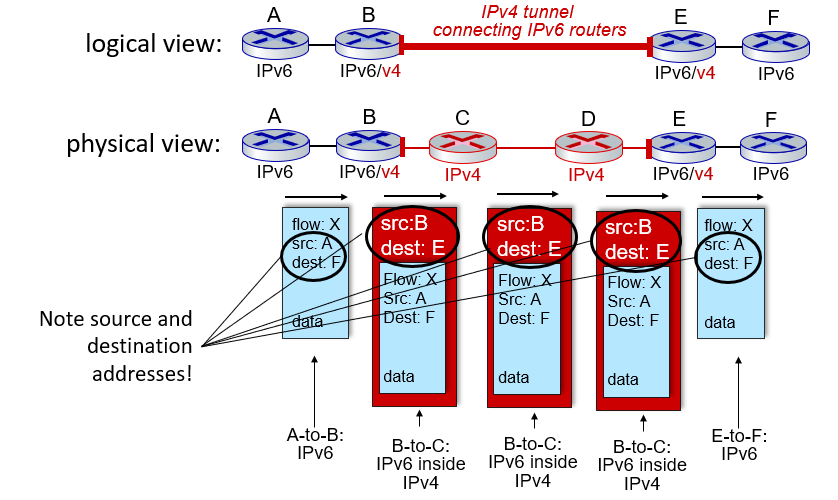
Routing Protocols
Goal: determine “good” paths (equivalently, routes), from sending hosts to receiving host, through network of routers
graph: G = (N,E)
N: set of routers = { u, v, w, x, y, z }
E: set of links ={ (u,v), (u,x), (u,w), (v,x), (v,w), (x,w), (x,y), (w,y), (w,z), (y,z) }
ca,b: cost of direct link connecting a and b
e.g., cw,z = 5, cu,z = ∞
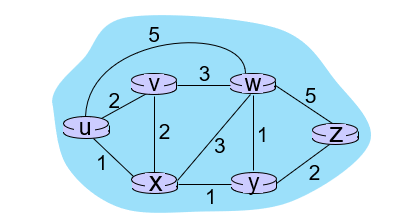
Routing Algorithm Classification
global: all routers have complete topology, link cost info
“link state” algorithms
static: routes change slowly over time
decentralized: iterative process of computation, exchange of info with neighbors
routers initially only know link costs to attached neighbors
“distance vector” algorithms
dynamic: routes change more quickly
periodic updates or in response to link cost changes
Dijkstra algorithm (aka How link states work)
computes least cost paths from one node (“source”) to all other nodes
gives forwarding table for that node
WILL NEED TO MAKE THIS TABLE FOR ALL DIJKSTRA TABLES

[A] Centralized vs Decentralized Routing
[B] (T/F) Link State is centralized routing algorithm
[C] How link state achieves centralized on decentralized property
[A]
Decentralized:
Iterative process of computation, exchange of info with neighbors
Routers initially only know link costs to attached neighbors
Centralized:
Network topology, link costs known to all nodes
[B] T
[C] Through link state broadcast, all nodes have same info which is all routers know the topology
What is the job of link layer? Packet name?
(1) To send packets from one node to adjacent node
(2) Frames
Flow control vs congestion control
Flow
Sender and receiver focused, lets you know how much the sender can send and receiver can handle
Congestion
Entire network traffic
Link Layer Services
(1) Framing
encapsulate datagram into frame, adding header, trailer
(2) Reliable delivery between adjacent nodes
(3) Error detection
errors caused by signal attenuation, noise.
Transmitting nodes adds error detection bits in the frame
receiver detects errors, signals retransmission, or drops frame
(4) Error correction
receiver identifies and corrects bit error(s) without retransmission
Multiple access links
Point-to-point
point-to-point link between Ethernet switch, host
PPP, HDLC (High-level Data Link Control)
Broadcast (shared wire or medium)
old-fashioned Ethernet
upstream HFC in cable-based access network
802.11 wireless LAN, 4G/5G, satellite
MAC (Media Access Control) protocols
Three broad class:
Channel partitioning
divide channel into smaller “pieces” (time slots, frequency, code)
“Taking turns”
nodes take turns, but nodes with more to send can take longer turns
TDMA: time division multiple access
Get full bandwidth but only during your timeslot
If no one uses it, wasted bandwidth also gotta wait your turn
FDMA: Frequency division multiple access
Set frequency just for you, can only broadcast in that range
Unused = idle, wasted
Taking turns in more detail
Polling:
master node “invites” other nodes to transmit in turn like round robin
typically used with “dumb” devices
concerns:
polling overhead
delay
single point of failure (master)
“Taking turns” MAC protocols Pt 2
Token passing:
control token passed from one node to next sequentially.
token message
concerns:
token overhead
latency
single point of failure (token)